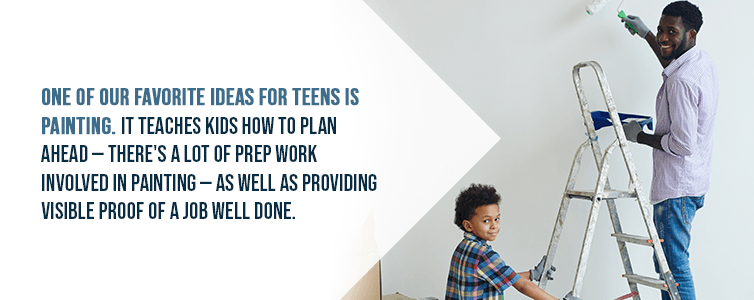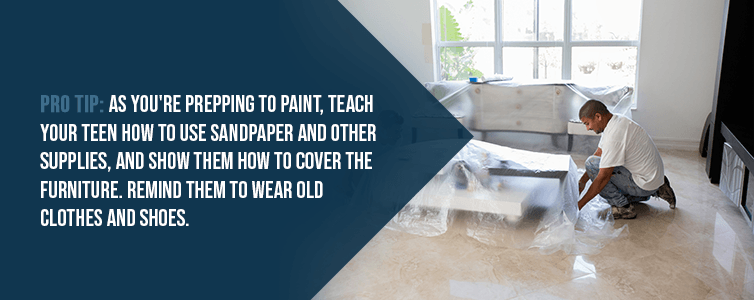
On average, teenagers spend 8.6 hours each weekend on their phones, watching television, playing video games, browsing social media and texting with their friends. As a parent, you're probably not surprised by that statistic. You're also probably looking for ways to redirect your teenager's attention away from some of those activities. After all, the way your teen spends their time now will have a significant impact on the way they spend their time as an adult. Now is the time to build in-person relationships and teach them life skills they'll need once they're living on their own.
Easier said than done, right?
If you're looking for ways to teach your teenager to contribute to the household — and maybe spend a little quality time with Mom and Dad — then consider involving them in a household project that captures their attention.
Benefits of Engaging Teens in Household Projects
Besides affording you the opportunity to pull their attention away from technology, involving your teen in a household project allows you to:
1. Spend Quality Time Together
Engaging in an activity together generates special memories that you'll share for years to come. It also affords you a natural setting for engaging in conversation and a mutual goal — two things that go a long way toward building a relationship.
2. Empower Your Teen
When you involve teens in household projects, you're teaching them how to be responsible for what belongs to them. And, as they become more comfortable with smaller tasks, they'll feel empowered to tackle bigger projects independently.
3. Prepare Your Teen for Adulthood
As you work on home improvement projects with your teen, they will learn a variety of practical life skills. Depending on what they work on, these skills may involve tool safety, teamwork, planning, organization, budgeting, and more.
4. Work Toward a Common Goal
The best way to create stronger bonds between family members is to give them a common goal to achieve together. This can come in many forms, but engaging your teen and their siblings in household projects teaches them how to work together to create something. When they're finished, they'll feel more connected as they take pride in and celebrate the end product.
Paint Your Way to Preparedness
Now that we've convinced you that household projects are a great way to engage your teenager in something other than their smartphone, you're probably wondering where to start. After all, you don't want to start with something complicated or boring — you want them to enjoy what they're doing and ask to do it again!
One of our favorite ideas for teens is painting. It teaches kids how to plan ahead — there's a lot of prep work involved in painting — as well as providing visible proof of a job well done.

If you're looking to really motivate your teen, start them off by painting THEIR room. Their bedroom is likely one of the smaller rooms in the house, and it also is the room that they have the most attachment to.
Attachment = motivation!
Once you've decided to paint their bedroom, what's next?
1. Do the Math
Enlist your teen to help with measuring the walls to determine how much paint is required prior to purchasing. Don't forget to measure the ceiling if you're planning to paint that too!
Pro Tip: As you're measuring, sprinkle in some life tips by teaching about measuring everything twice and buying slightly more paint than what you think you need to keep on hand for touchups.
2. Choose the Paint Color
Grab your teen and head to the nearest home improvement store. Spend some time browsing through their selection of printed paint samples. Still not sold on a specific color? Most stores will give you small cans of the colors you're considering to take home and put on a wall in the room you're going to paint.
Pro Tip: If you have a child who might choose a color that’s a bit too crazy for your tastes, narrow it down to a certain color family before you head to the store. Or, if you're not willing to risk a public argument in the middle of the paint section, pre-select some options you’re comfortable with and then let your tween/teen choose from the options at home.
3. Organize the Room
Before you can even set up your painting supplies, you'll need to clean up the room and move stuff out of the way. Take advantage of this time to purge old clothes, toys and other items your teen no longer uses. Depending on your teen, you may need to oversee this process. Provide boxes, bins, and trash bags for them to separate and sort items that are leaving their room.
Pro Tip: Encourage your teen to donate items they no longer use to a local charitable organization. Teaching them to give back to their community is a great bonus lesson for this project!
4. Final Prep
Once you've got the paint, it's time to patch any holes in the walls, then sand them flush with the drywall. Tape edges and corners, spread plastic tarps to cover flooring and furniture. This would also be the stage in which you'd apply primer to the walls, but many paints today come as a paint and primer combination. Before you get started, make sure you know what you bought and whether the primer is necessary.
Pro Tip: As you're prepping to paint, teach your teen how to use sandpaper and other supplies, and show them how to cover the furniture. Remind them to wear old clothes and shoes.

5. Paint
Depending on your teen's age and ability, you may want to handle the cutting — detailed painting near corners, ceiling, windows, and trim. If you have a particularly detail-oriented or artistic teen, they may be able to help once you show them what to do. If not, have them focus on painting between the lines you create. They can do this with a brush or a roller. Make sure they know that it might take two coats to achieve the color they're looking for.
Pro Tip: Keep some damp rags nearby to quickly clean up mistakes or spills that occur.
Landscape Your Way to Leadership

Another great home project for teens to get involved with is working in the yard. Landscaping teaches your child leadership, as well as effective communication. They'll also need to learn how to delegate to efficiently and effectively complete the project.
What's the best way to get started on a landscaping project with your teen?
1. Map It Out
Include your teen in the initial design and planning stages. Ask them to help to map out the backyard and identify areas that need improvement or updates.
Pro Tip: Many teenagers may not be familiar with specific plant names or types. It may be helpful to ask them to identify the areas for improvement and then present them with some choices for how to make those improvements.
2. Set a Budget
Make a realistic budget that details how much you want to spend, and include your teen as you look for innovative ways to stick to it, such as looking for alternative materials and sales. Allow your teen to choose which plants and landscaping materials should be added to the area and encourage them to research which plants should be placed close to each other, which areas would be best for each plant and other considerations. Remind them to stick to the budget and have them tally up the costs to ensure they're doing so.
Pro Tip: Have your teen visit a nursery with you or help you browse for information online. While you're looking, engage them in conversations about conservation, climate, and other gardening-related topics.
3. Pick Out Materials
Once you've developed a plan and a budget, it's time to get everything you need. Take them with you to purchase your plants and supplies so that they can see the results of the planning and budgeting.
Pro Tip: This can also be helpful because your teen can help carry plants and load them into your vehicle once you've purchased them. Now you've got them exercising too!
4. Let Them Lead
Now that you have your materials and a plan, give your teen some time to practice being the leader. Encourage them to delegate, prioritize, and effectively communicate with their team, aka mom and dad, by telling you what needs to be done.
Pro Tip: Including other siblings in the implementation of the plan can help speed things up. Enlist the help of other siblings to spread mulch, water new plants, and mow the grass. Turn it into a family affair!
5. Thinking Ahead
Once you've finished the initial landscaping, come up with a plan for maintaining it. Will your teen be responsible for trimming and watering? Do you expect them to keep the grass mowed?
Pro Tip: Although it's tempting, don't rely solely on your teen to complete all the yardwork. It's important that they see you out there trimming, mulching and caring for the yard too. When you're doing it together, they feel like they're a part of something, rather than just your gardener.
Deep Clean Your Way to Decision Making
Even if your teen does the dishes or vacuums their room occasionally, deep cleaning is a more involved process that teaches a lot about time management and prioritizing. It's also an excellent opportunity to teach teens what it means to be detail-oriented. Although many families reserve this type of cleaning for "spring cleaning," engaging your teen in more frequent deep cleaning practices can have a lot of benefits for you — and them — in the long run.
1. Explain the Difference Between Unsanitary and Untidy
Deep cleaning sets the stage for a discussion about the differences between keeping a room "tidy" and "clean." Although most dirty rooms don't qualify as a health hazard, spend time talking about the reasons they need to keep their room clean, such as avoiding pests, bacteria, and mold growth.
ro Tip: Avoid attacking your teen's habits or making them feel bad if their room is out of control. Focus on the general practice of cleaning and teaching them to develop good habits.
2. Set Your Standards
If you're being honest with yourself, were you tidy as a teen/tween? Set some standards for cleanliness, but be open to negotiating. For example, instead of forcing your teen to make their bed every morning and arguing when it's not done, find another chore that they are more likely to be successful in completing, such as bringing dishes out of their room and putting them into the dishwasher before bed every night. Also, consider whether your teen is more likely to cooperate and finish tasks at a particular time of the day. For example, your teen may be too tired at night to take out the garbage or clean up their bathroom. Consider asking them to complete these chores in the morning or on the weekend instead.
Pro Tip: Start small. If your teen hasn't been doing chores or cleaning up consistently, don't throw a huge list of responsibilities at them all at once. Choose one or two tasks to start with, then add more as they become used to doing them.
3. Set a Timeline
Rather than just telling your teen you expect them to vacuum their bedroom, give them a time frame. Say "I expect you to vacuum your carpet once a week" or "Every Saturday I expect you to empty the garbage in your room and the bathroom."
Pro Tip: While your teen may be too old for a "chore chart," write down whatever you tell them. Having it in writing can help you remember to check in with them to make sure things are getting done.
4. Customize Their Responsibilities
Each teen — and family — will have different needs and expectations. Customize your expectations accordingly. What are some common household chores teens can complete? Picking up and putting away their clothes, washing bed sheets weekly, wiping down the surfaces in their bedroom and bathroom each week, taking out the trash, doing dishes, and more. If you have more than one teen at home, assign responsibilities in a way that shows each of them has the same expectations from Mom and Dad.
Engaging Teens in DIY Projects
Engaging your teen in household projects is a great way to teach responsibility, life skills, and family togetherness. It can be challenging to motivate teens to put down their phones and pick up a paintbrush, but the end result and their satisfaction with a job well done are always worth it.
Another great way to engage your teen in a household DIY project is by installing Focal Point Crown Molding. A practical and affordable alternative to traditional hard-to-install crown molding, Focal Point products give you the look of wood or plaster molding in a light-weight, easy-to-install product. Best of all, you can install all of our molding products with standard hand tools and no experience! Featured on This Old House and the DIY Network, these one-of-a-kind products are a game-changer when it comes to DIY projects in your home.

Get started on your next household DIY project. Browse our selection and find the style that's right for your home today!